Over 100 researchers, manufacturers, industry insiders, academics, and other lighting stakeholders from the U.S. and abroad gathered for the 2024 Research Symposium, held May 15-16, 2024, at the Oregon Museum of Science & Industry (OMSI) in Portland. The gathering serves as a cornerstone for planning for its co-sponsors and long-standing partners—the Illuminating Engineering Society (IES) and the U.S. Department of Energy (DOE)—and seeks to advance the quality and efficiency of lighting through engineering, science, design, and collaboration. The 2024 gathering returned to an in-person format after a three-year hiatus and offered all the advantages of “live” communication, dialogue, and debate.
Leveraging the face-to-face opportunities, speakers and participants engaged in robust conversation to discuss the critical R&D needs of our time, identify opportunities for collaboration, and learn more about the latest tools that will shape the future of lighting. The frank and informative dialogues inform the missions of both DOE and IES—helping to establish the research priorities of both organizations, with ripples affecting the entire lighting world. With this in mind, the sessions focused on a wide range of topics: research trends for next-generation lighting tools, new recommendations and methods to evaluate health impacts of lighting, innovative approaches to lighting practices, novel tools for post-occupancy evaluations, and design for resiliency.
Wednesday, May 15, 2024
Colleen Harper, IES executive director, welcomed attendees to Portland and to the Symposium. She then introduced Wyatt Merrill, technology manager for DOE’s Lighting program, who highlighted the value of this gathering and how input from the lighting research community helps to shape DOE R&D priorities. He shared updates about current DOE funding opportunities, and announced the publication of the latest edition of DOE’s Lighting Market Characterization report, which provides a comprehensive dataset on installed lighting stock, operating hours, wattage, and energy use. The report shows the tremendous progress made by LED technology while also underscoring how much work remains to be done in building types where LED adoption lags (e.g., educational facilities, multifamily buildings). Merrill also described GUV research efforts to evaluate the effectiveness, safety, and energy use of GUV products, and related efforts to share results among researchers and practitioners to identify needs and best practices. Lastly, Merrill highlighted the L-Prize® competition and its recently launched Manufacturing and Installation Phase, pointing to the L-Prize panel discussion with Prototype Phase winners to follow later in the day.
Merrill then introduced Brienne Musselman, IES director of education and standards, who began by thanking the Symposium planning committee. Musselman described IES’ global footprint, with members located in more than 50 countries, and highlighted their important work in developing standards for lighting application and practice, measurements and testing, lighting science, and roadway/parking lot lighting. She urged attendees to join an IES committee and share their research and expertise. Musselman concluded with a preview of upcoming IES events: lighting education tours to five cities in May, June, and July; the Museum Lighting Symposium in June, and the Annual Conference in August.
Ecological Considerations
Dan Weissman of Lam Partners kicked off the first panel with an overview of lighting and ecological considerations, setting the stage for the panelists to dive into the most pressing ecological issues of the moment: life cycle assessment (LCA) and the pressures that light at night place on the broad range of nocturnal species. Weissman noted that since the dawn of civilization, humans have put increasingly large pressures on our earth's environment. Lighting is both a relatively small component of the building industry, yet also the most visible sign—at least in the visible spectrum—of advanced terrestrial civilization development. Weissman stated that lighting design intersects several topic areas, each with their siloed research areas. Typically, each topic is discussed on its own terms.
Each presenter then offered a unique perspective on how lighting can consider the ecology of our planet, with Kate Hickcox of Pacific Northwest National Laboratory (PNNL) introduced first. Hickcox discussed leveraging life cycle thinking for positive impact, explaining that when designing or specifying a material, product, or project, impacts must be considered comprehensively. She introduced the concept of LCA, which can provide this comprehensive view by considering the environmental impacts associated with all stages of the life cycle and by investigating environmental impact across a variety of categories. She then gave an example of life cycle thinking, using the life cycle of a bagel. Hickcox rounded out the talk with a list of barriers to LCA implementation for lighting and discussed how data-driven innovation can address these barriers, giving specific examples such as the current effort to develop a North American product category rule (PCR) for lighting, and the luminaire life cycle inventory template that PNNL has developed to automate, standardize, and expand LCA use in the lighting industry.
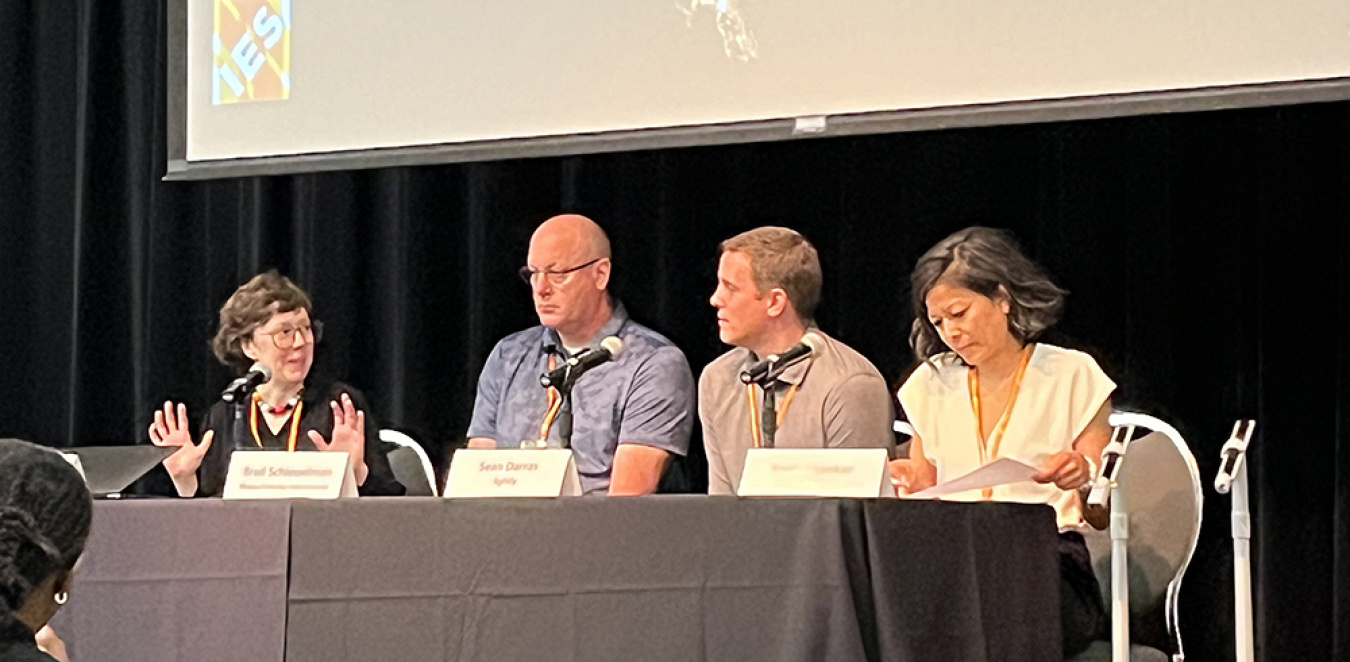
The Ecological Considerations panel.
Brad Schlesselman of Musco Lighting and DarkSky International looked at the topic of anthropogenic light at night and its effects on the natural world. Schlesselman discussed the five principles of responsible lighting, with a focus on sky glow and how energy efficiency may have an inverse relationship not only with sky glow but also with stray lighting and light trespass. He led the audience through a demonstration using mounting stands, flashlights, and lenses for LED flashlights to show the value of distribution and directionality in lighting design.
Sean Darras, founder of three manufacturing companies in the Philadelphia area, provided a unique focus on manufacturing, discussing the relationship between embodied and operational carbon in lighting. Darras presented findings from the GreenLight Alliance LCA Incubator, a pilot study that invited industry to work across expertise and territories to address the impact of lighting design on people and the planet. He covered LCA Incubator data and results representing five architectural luminaire types as well as other materials-related findings linked to impacts from steel and aluminum. He also highlighted some of the approaches taken by one of the companies he founded, Lightly, and concluded with thoughts and tips for the lighting industry.
Leela Shanker, design lab director with WAP Sustainability and founder of the LCA Incubator, rounded out the panel with a wide-ranging talk inspiring the audience to “rewire your design practice.” Shanker asserted that rewiring was needed at all levels, from individuals to businesses to governments and the economy. She discussed the challenges for data collection from complex products, and the roles of different industry stakeholders. She followed up on Darras’ discussion of the LCA Incubator findings, then wrapped up by discussing a systems approach focused on collaborative, science-based, harmonized solutions.
Design for Resiliency
This session explored the latest thinking on design for resiliency in lighting. With Kate Hickcox of PNNL moderating, the session began with Nelson Jenkins, principal of LumenArch, providing real-life examples of resilience-focused North American architectural lighting projects. He discussed a LumenArch lighting project at Raspberry Island in St. Paul, Minnesota, where a former marshland along the Mississippi River experienced frequent flooding. The team created a lighting plan that was resilient to flooding while aligning with the architecture, providing many lessons learned for future work in potential flood-prone areas. Jenkins also discussed the Jersey City Municipal Center, a LEED-Platinum project that includes a 19-acre site where photovoltaic (PV) streetlights provide energy independence as well as reduced wiring and maintenance. The campus includes four buildings and features net-zero electrical consumption and PV panels that generate 1.1 MW. Jenkins shared a third project meeting zero energy building codes, the New York City Department of Design & Construction’s Orchard Beach Maintenance and Operations Building, located at the only beach in the Bronx. The 24-hour emergency facility built in a flood hazard zone supports beach operations and features a reduced number of lighting fixtures for ease of maintenance, and one LED board and programmed drivers for pendant, wall, and surface lighting.
Szymon Slupik, CTO at Silvair and chair of the Mesh Working Group at Bluetooth SIG, began his presentation by defining resiliency within the context of wireless networked lighting controls (NLCs). Resiliency, he explained, means that the products carry on regardless of potential disruptions, and components have fully open interoperability. Slupik looked at the differences between wired and wireless architectures and presented a case that Bluetooth NLCs deliver the resilience that is needed, due to the lightest-possible package, redundancy on every level, and mandatory, fully verified security. In addition, Bluetooth NCLs offer fully replaceable lighting components and resiliency through the open standard. However, Slupik cautioned that the “elephant in the room” remained software complexity that necessitates increased quality assurance and long-term testing.
L-Prize Innovation
Gabe Arnold of PNNL moderated the L-Prize session and began with an overview of the competition, highlighting the primary goal: Development of more energy-efficient and connected commercial lighting solutions that are also more accessible and affordable. He explained that historical tradeoffs have long existed between high luminaire efficacy, quality of light, connectivity, and cost/affordability. Similar tradeoffs exist with connected lighting systems, such as providing advanced capabilities and benefits while also being interoperable, accessible, and affordable. Arnold then posed a series of questions for his panelists, comprised of L-Prize Prototype Phase winners—Scott Metker of Autani, Cary Eskow of the Grid Interactive Efficient Building Alliance (GiEBA), Sean Darras of Lightly, Stephen Zhou of MW Connect, and Jose dos Santos of Signify:
- To develop luminaires that have it all… highly efficient, excellent quality of light, smart, interoperable, AND affordable and accessible … where are the biggest challenges, conflicts, and tradeoffs? What research and innovations can help address these conflicts and challenges?
- To develop connected systems with increasing value and functionality such as fault detection and diagnostics, grid service capabilities, interoperability with HVAC and other systems – while also being easy to install and use AND affordable and accessible – where are the biggest challenges, conflicts, and tradeoffs? What research and innovations can help address these conflicts and challenges?
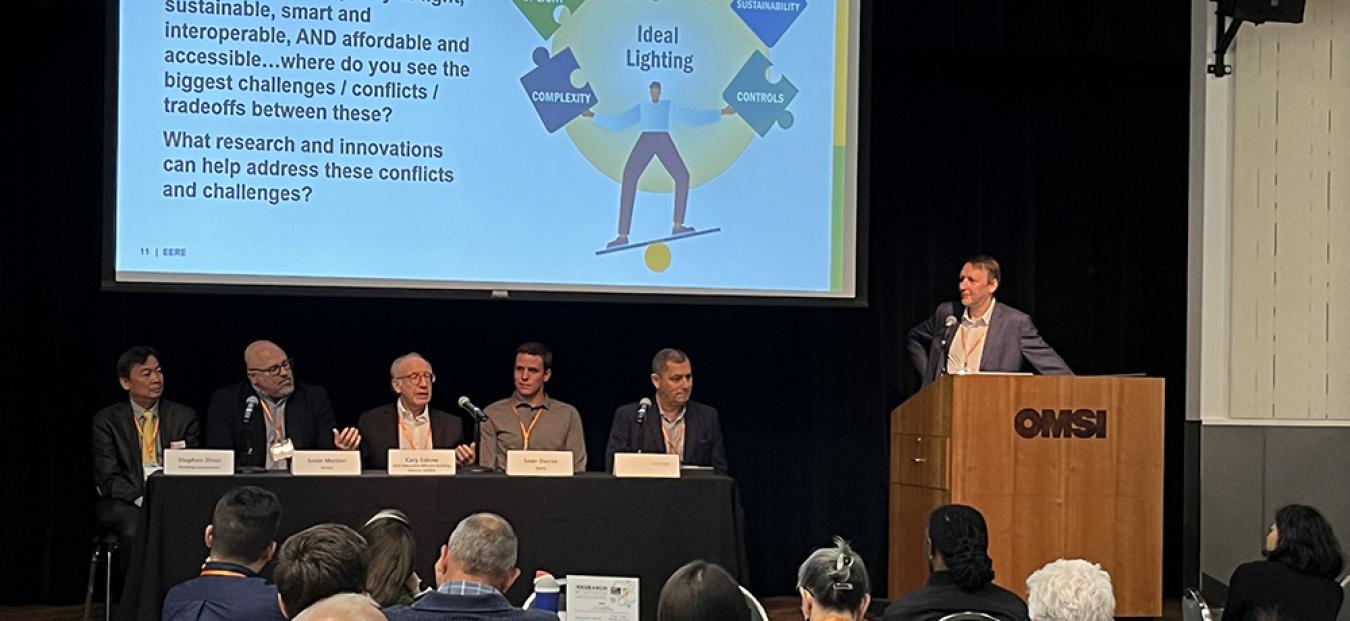
The L-Prize Innovation panel.
A wide-ranging discussion followed with the audience and panelists. Luminaire trade-offs between high efficacy, quality of light, and recycling and reuse were explored. The audience and panelists particularly homed in on the challenges of connected lighting systems, which can provide significant energy and non-energy benefits to commercial buildings and occupants but still have low market adoption. As the panel discussed, the L-Prize Prototype Phase brought forward significant innovations in connected system interoperability, digital control, and grid service capabilities. The audience and panelists discussed the need for research and quantification of the benefits of these innovations, and the important need for policies and rebates to help drive demand and realize adoption. The session concluded with a look toward the next L-Prize phase – Manufacturing and Installation – where the L-Prize innovations will become commercially-available products installed in real buildings.
Topic Table Discussions
Day one ended with topic table discussions, where attendees picked a research topic and met in small groups to discuss the topic in depth and share their knowledge and expertise with DOE and IES. What are the most notable emerging research trends? What are the key challenges, and how should R&D address them? Topics spanned a range of R&D challenges for lighting: the impact of lighting on human health, outdoor nighttime environment, lighting controls, resilience, daylighting, and more. Some “questions to consider” were provided for each topic to spur the discussion. Inputs from each group will guide planning for future DOE and IES research activities as well as IES technical committees.
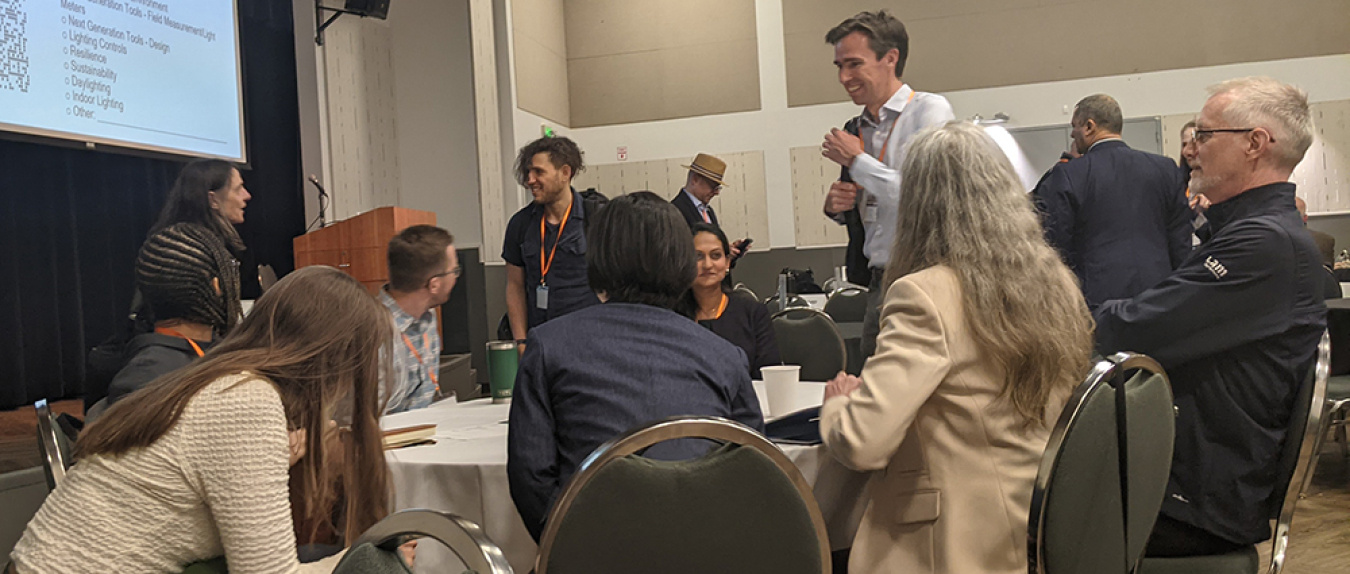
Topic table discussions.
Thursday, May 16, 2024
Light and Health: Translating Research into Recommendations
Day 2 of the symposium began with an exploration of the latest thinking from researchers on the impact of light on human wellbeing and eye health, and the challenge of translating research into new recommendations. Moderated by Morgan Pattison of SSLS Inc., the panel began with Dr. Steven Lockley of Harvard Medical School. Lockley covered the development of our understanding of non-visual physiological responses to light based on research findings and the development of lighting application guidance based on these findings. The understanding of the receptors and non-visual physiological responses to light is relatively new and requires new lighting design guidance beyond the role of lighting for vision.
Renske Lok of Stanford University spoke next on the topic of optimizing health through light. Lok described recent research and the research methodologies necessary to tease out understanding of the relationships between the effects of light on circadian entrainment, alerting, and sleep, including the connection between the intensity of light and alertness. Lok highlighted results from a study of Olympic athlete performance in various times zones and at different times of day.
Lisa Ostrin from the University of Houston presented on the influence of light on the eye. She described a two-week study in which 21 adult test subjects wore blue-blocking lenses at night—which increased nighttime melatonin production by 58 percent, increased sleep duration by an average of 24 minutes, and led to a reported improvement in sleep quality. Ostrin then presented recent research and understanding on the relationship between light conditions and the growing epidemic of myopia and light treatments to slow its progression. Myopia is a growing global epidemic, with 50 percent of the population predicted to be diagnosed as myopic by 2050, leading to the increased risk of retinal tears, retinal detachment, macular degeneration, and other complications. She described recent research that makes the connection between light input and circadian rhythms and myopia and showed the promising results of low-level, red-light therapy—among other treatments—to combat myopia.
Next-Generation Lighting Tools
This session explored the next generation of tools available and needed for architectural lighting to meet current and future demands. Moderator Mark Lien of IES opened the session by highlighting multiple trends. New lighting products and software are being adapted to meet new market expectations. At the same time, the internet, electronics, and telecom industries are converging with the lighting industry, with the intent of adding lighting to their offerings. Trends including lighting for health and recyclability are triggering new standards that provide guidance and guiderails for lighting professionals. And artificial intelligence is impacting design and is poised to be integrated into industry practice and processes.
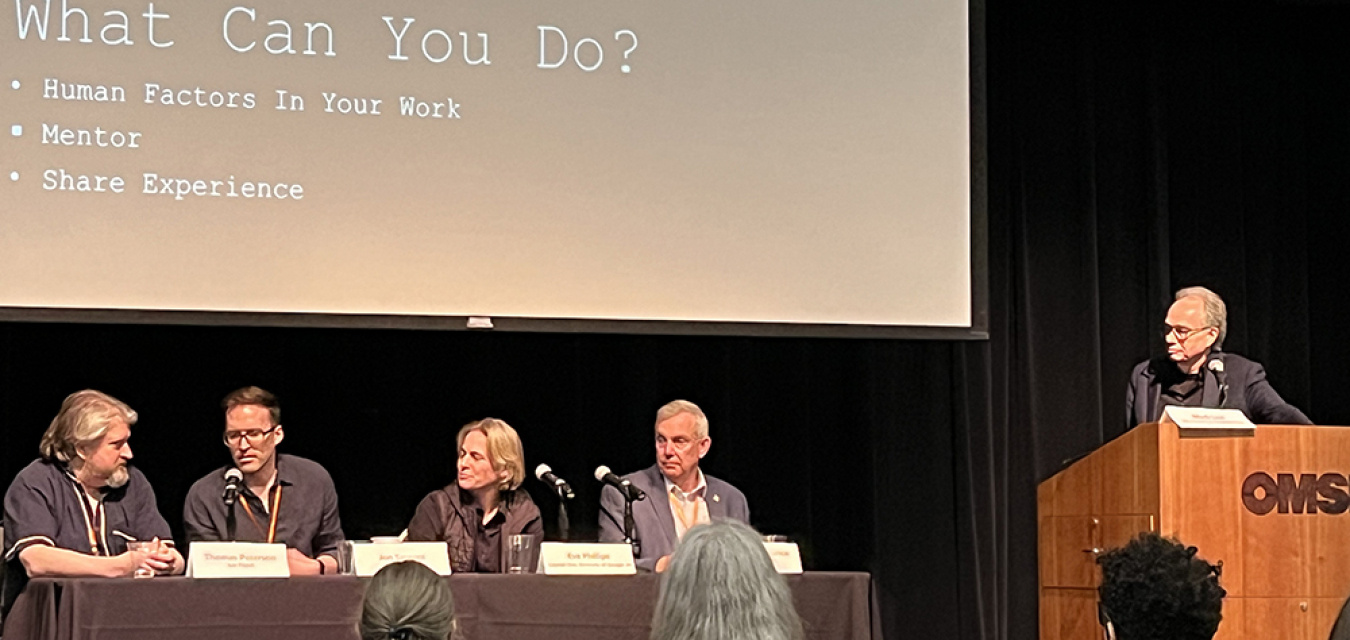
The Next-Generation Lighting Tools panel.
Lein introduced Kevin Fitzmaurice of Sesco Lighting, who defined standards as “a form of technical infrastructure” resulting from a collaboration of many contributors that creates competition within a standardized framework and establishes a baseline from which innovations can emerge. As an example, Fitzmaurice then discussed the specification and use of new D4i power supplies with roadway luminaires. D4i enables asset tracking, including identification of fixture specifications, energy and power reporting for rebates and sensor and controls strategies, and diagnostic and maintenance information for troubleshooting. D4i power supplies have a standard receptacle and common data format, enabling interoperability of different fixtures and ease of data transfer.
Thomas Paterson of Lux Populi discussed the need for trained human judgment when it comes to lighting products and cautioned against over-reliance on design software that removes the human element in lighting designs, particularly unusual lighting situations. Eve Phillips discussed her experience with artificial intelligence at Google and how it can be effective for design optimization processes, although it is not the best tool for solving multi-variable physics equations.
Finally, Jon Sargent from Solemma discussed the DOE-funded development of Solemma lighting design software. This software uses ray tracing to analyze illuminance levels at numerous planes within a space. It also characterizes the delivered spectral power distribution at the various planes, which is critical for evaluating human physiological responses to lighting at different locations, orientations, and postures within a lighted space.
Novel Methods for Post-Occupancy Evaluations
Moderated by Andrea Wilkerson of PNNL, the final session highlighted novel methods for characterizing occupant light exposure and explored how these methods can deepen our understanding of the relationship between lighting conditions in real-world applications and occupant outcomes. Dr. Shadab Rahman of Harvard Medical School/Brigham and Women’s Hospital amplified information from previous presenters, including the importance of high-intensity, blue-enriched light during the day. He discussed how lighting affects health outcomes in applications ranging from senior care to the space station, highlighting how visible light exposure induces a wide range of physiological responses beyond vision—including mood changes, gene expression, and hormones. Rahman emphasized the need for application-specific solutions for light intervention, and the need to identify primary stakeholders and key performance indicators.
Dr. Siobhan Rockcastle of the University of Oregon explored the impacts of design and behavior on eye-level light exposure, including the nuanced behavior of occupants moving throughout buildings. She shared results of a study evaluating temporal and spatial light exposure for select occupants in a typical building, including a senior manager, junior manager, IT manager, and intern. Another study involved circadian exposure for a “perimeter dweller” and a “core dweller” in a Miami building and the amount of healthy light experienced by each during the workday. She called for a metric that explains the potential to receive enough light exposure by different populations within buildings.
Mike Martinez of Atelier Ten looked at the interpretation of post-occupancy evaluations for complex daylighting systems. He reminded the audience of the need to root design in human experience, and that understanding users can be just as helpful as rigorous research. Martinez provided an honest look at the positives and negatives of advanced facades (for glare control, daylight, outside views, energy, and control of solar heat gain) from the perspective of the occupant and building owner.
Optional Tour of PNNL Lighting Science & Technology Lab
The optional tour of PNNL’s lighting lab, which closed out the gathering, provided an up-close look at DOE research into some of the most profound issues in lighting. Nine stations offered the opportunity to observe research efforts in progress. Three stations looked at various aspects of flicker. At one station, an installation of Type B TLEDs evaluated the photometric performance of available products and, more importantly, looked at flicker characteristics. Flicker waveforms were measured at a second station while a third demonstrated how application factors can influence the perceivability of the stroboscopic effect and phantom array effect. Another station involved measuring the effectiveness of automatic lighting systems to detect faults and respond to signals from the electric grid while another looked at core daylighting via scale models. Yet another station demonstrated the PNNL spectrally tunable lighting facility and showed the results from a recent experiment examining the intersection of spatial brightness perception and color rendition. The tour provided a first-hand look at multiple investigations underway and provided an opportunity for attendees to direct questions to the PNNL researchers on hand.
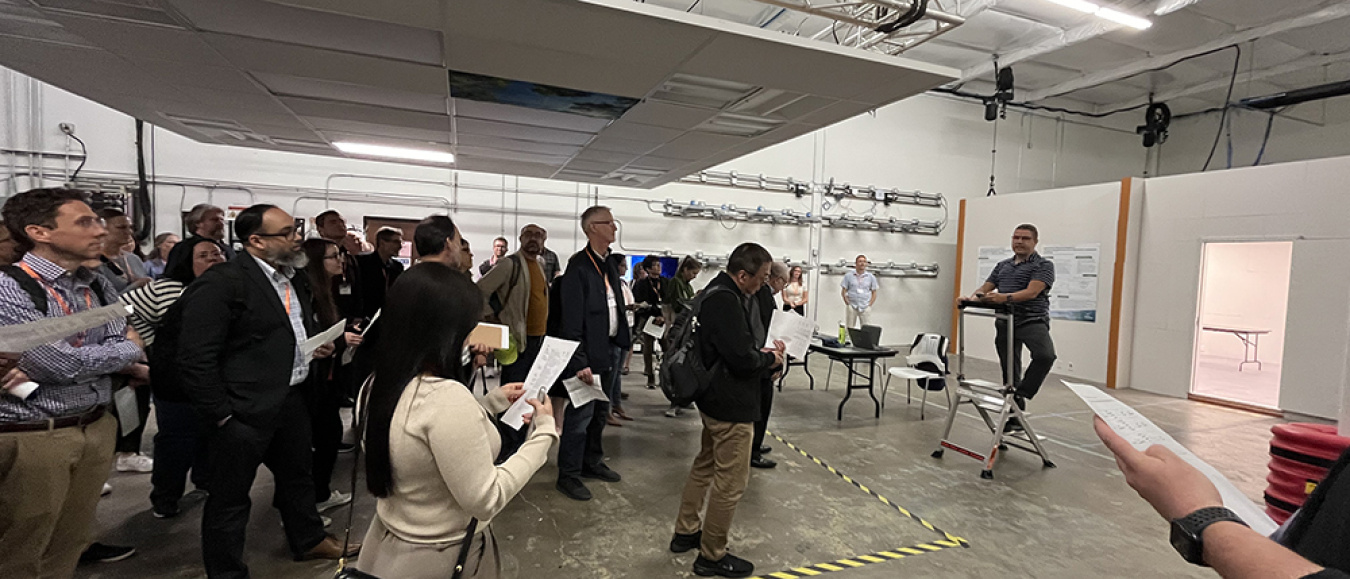
Tour of the PNNL Lighting Science & Technology Laboratory.

